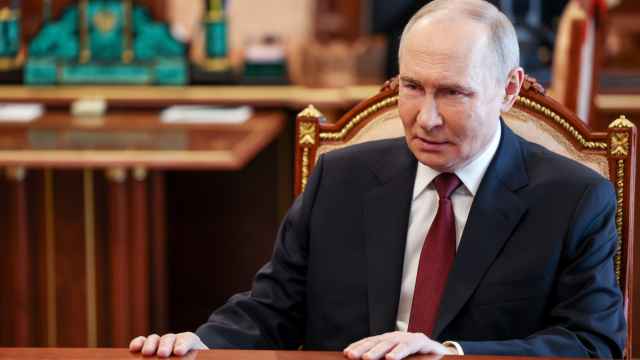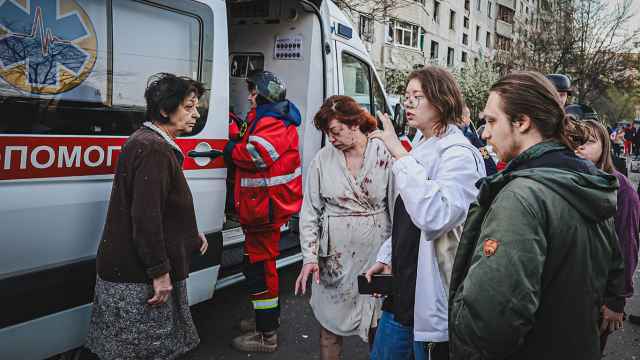At least 10 people were killed and more than a dozen injured when a machine room flooded at the Sayano-Shushenskaya hydroelectric plant, knocking out power in several Siberian regions and causing a panic near Russia’s largest dam.
The plant, owned by state-controlled RusHydro, was halted after suffering “billions of rubles” of damage, and it could take as many as four years to be completely repaired, chief executive Vasily Zubakin said. The lost electricity could also dampen sales for metals firms with plants nearby, including United Company RusAl and Evraz Group.
At least 72 workers were still missing almost a full day after a water pipe burst at 4:13 a.m. local time at the plant, located in the Khakasia republic village of Cheryomushki, four time zones east of Moscow.
Reached by phone late Monday, Roman Domtsev, a spokesman for the Siberian branch of the Emergency Situations Ministry, said rescuers “of course” hoped to find more people alive.
Despite public assurances from local officials and Emergency Situations Minister Sergei Shoigu that the dam was not damaged, residents began fleeing in fear that the Soviet-era structure on the Yenisei River could collapse.
“People started refilling the gas in their cars, buying bread, salt and matches and moving uphill,” Olga Kolesnikova, spokeswoman for the regional government, said by phone from Abakan, Khakasia’s capital.
More than 100 people, including plant workers, rescue teams and prosecutors, were working at the scene.
Repairs were being done in the room when the pipe burst, but the actual cause of the accident remains unclear.
RusHydro said a “water surge” that resulted in a jump in pressure caused the pipe to burst. The company denied earlier comments by Investigative Committee spokesman Vladimir Markin, who said the accident was caused by a transformer explosion.
Two of the station’s 10 power units were destroyed and two more damaged, RusHydro said in a statement.
“Several leads are being investigated,” Kolesnikova said. “One is that water with stones got into the pipe.”
The accident was reported to regional officials at about 4:40 a.m., she said. To prevent a short circuit, power was cut to the machine hall, and several power stations were switched to alternate lines to bring back power to office and apartment buildings, she said.
The search for missing workers has been difficult because the machine hall has many rooms, the doors to which are blocked, said Domtsev, the Emergency Situations Ministry spokesman.
Divers were working to open doors and find the missing people, he said.
The accident also spilled tons of oil into the river, spreading over 25 square kilometers, the Natural Resources and Environment Ministry said.
President Dmitry Medvedev ordered Shoigu and Energy Minister Sergei Shmatko to travel to Abakan to coordinate efforts on minimizing the consequences of the accident, the Kremlin press service said in a statement.
Shmatko and Shoigu also met in Moscow with RusAl CEO Oleg Deripaska and RusHydro chairman Vyacheslav Sinyugin to discuss the accident.
Prime Minister Vladimir Putin ordered his deputy Igor Sechin, who oversees the energy and power sectors, to form a commission to look for ways to bring the plant back on line as quickly as possible, Interfax reported.
Putin later visited the Emergency Situation Ministry’s crisis center and held a conference call with officials on the scene. The plant’s head engineer, Andrei Mitrofanov, said late Monday that 72 people were still missing.
The Investigative Committee said it opened a criminal investigation into possible violations of work safety laws, which carry a sentence of up to three years in prison. It did not elaborate.
A commission headed by Shmatko will also investigate. RusHydro subsidiary Lengidroproyekt, which designed the plant, and Power Machines, which delivered the power units, will also take part in the investigation, a RusHydro spokeswoman said.
To compensate for the power deficit, hydropower plants in Krasnoyarsk and Bratsk will operate at maximum capacity, while heat plants in 10 Siberian regions will use reserve capacities, the Energy Ministry said. The ministry warned that there could be temporary outages in the Altai, Khakasia, Tomsk, Kemerovo and Novosibirsk regions.
RusHydro will pay 1 million rubles ($31,000) to the families of each worker killed, said Anatoly Kvashin, the presidential envoy to the Siberian Federal District, Interfax reported.
Construction of the Sayano-Shushenskaya power station was started in 1968, and it is the primary generator for RusAl’s Sayanogorsk and Khakas aluminum smelters and two Evraz steel plants in the Kemerovo region. A second module was built in 1979 and partially reconstructed in 1987.
Asked whether the plant’s equipment could have worn out, Khakasia regional spokeswoman Kolesnikova said it was unlikely.
“I can’t imagine it,” she said. “The plant has enough money to invest in new equipment, and there are highly qualified experts who constantly check everything.”
After ranking second to the United States for installed hydropower capacity during the Soviet period, Russia allowed the industry to stagnate for the majority of the 1990s while it completely restructured its electricity industry.
In a statement dated Aug. 11, RusHydro said Sayano-Shushenskaya was operating at record capacity, despite using just nine of its 10 power units.
“The inflows of the Yenisei River are 10 percent above the average of the past several years,” the statement said. The plant produced 2 billion kilowatt hours of power more than planned in the first seven months of the year.
Sayano-Shushenskaya’s capacity of 6.4 gigawatts comprises just over one-quarter of RusHydro’s total.
Zubakin, RusHydro’s chief, told reporters that damages could reach “billions of rubles.” The company will “mostly use its own resources” to repair the station and restart its operation, he said, Interfax reported.
Replacing damaged power units will take up to four years, Zubakin told RIA-Novosti. The units that were not damaged could restart operation within 1 1/2 months, he said.
The company’s Moscow-traded shares were halted shortly after the MICEX and RTS opened. No trades were registered on the RTS, but the blue chip’s shares fell nearly 7 percent before the MICEX halted them.
RusHydro’s London-traded shares were down more than 15 percent.
The Sayano-Shushenskaya plant is insured by ROSNO, and RusHydro could get $200 million for the damage, Prime-Tass reported. Losses for stoppages of several aluminum plants are insured by Ingosstrakh, its director told Prime-Tass.
RusHydro will bear the biggest losses, while the whole region will have to pay more for power after switching to coal and fuel oil, said Konstantin Reilly, a utilities analyst with Finam Investment. Sayano-Shushenskaya was expected to bring in about 15 percent to 16 percent of RusHydro’s profit in 2009, he said, “and we still don’t know how much they will need to pay for repairs.”
VTB Capital said in a note that RusHydro’s losses from the stoppage and unsold power could amount to $100 million. The company will also have to pay about $3 million per unit and possible environmental penalties, the note said.
“The event points to the poor condition of the equipment and lack of investment in the sector,” analysts Dmitry Skryabin and Mikhail Rasstrigin wrote.
Reilly disagreed that poor maintenance could be a cause. “It’s one of the best maintained hydropower plants, repaired regularly,” he said.
RusAl’s Khakas and Sayanogorsk smelters get their energy almost entirely from the damaged plant, while plants in Novokuznetsk and Krasnoyarsk are partially powered by Sayano-Shushenskaya, a RusAl spokeswoman said. The plants are operating normally, as they have been able to acquire energy from other sources.
Possible production cutbacks were discussed, however, during Deripaska’s meeting with the ministers, she said.
“The situation with power supply in the Kuzbass continues to be difficult,” Alexei Agureyev, a Evraz vice president, said by phone without elaborating. The Kuznetsk Basin, or Kuzbass, is one of the world’s largest coal mining areas.
Evraz is focusing all efforts on avoiding or minimizing production losses, he said. The company operates the Novokuznetsk and West Siberian metals plants in the Kemerovo region, as well as several coal mines.
RusAl strategy chief Artyom Volynets told Bloomberg that the accident could “shock” the aluminum market, as output may fall by 500,000 tons per year because of the disrupted power supplies, Bloomberg reported.
The figure is about 1.5 percent of global aluminum output, said Marat Gabitov, a metals analyst with UniCredit. “In the current situation on the market, this is not likely to impact prices,” he said. “If anything, the accident may serve as another reason for RusAl to close the inefficient plants in the Urals and use the electricity in the efficient plants, such as Krasnoyarsk.”
A Message from The Moscow Times:
Dear readers,
We are facing unprecedented challenges. Russia's Prosecutor General's Office has designated The Moscow Times as an "undesirable" organization, criminalizing our work and putting our staff at risk of prosecution. This follows our earlier unjust labeling as a "foreign agent."
These actions are direct attempts to silence independent journalism in Russia. The authorities claim our work "discredits the decisions of the Russian leadership." We see things differently: we strive to provide accurate, unbiased reporting on Russia.
We, the journalists of The Moscow Times, refuse to be silenced. But to continue our work, we need your help.
Your support, no matter how small, makes a world of difference. If you can, please support us monthly starting from just $2. It's quick to set up, and every contribution makes a significant impact.
By supporting The Moscow Times, you're defending open, independent journalism in the face of repression. Thank you for standing with us.
Remind me later.






